ABSTRACT
Indonesia is the largest nutmeg producer in the world sharing about 46.52% of the global harvested areas. Almost 60% of nutmeg planting areas are in eastern Indonesia, particularly in the Maluku and Papua regions. Most nutmeg farms belong to smallholders (99.81%). The productivity of Indonesia’s nutmeg was lower as compared to the productivity of other producing countries such as Malaysia, Sri Lanka, Dominica, Madagascar, and Togo. Indonesia was ranked third as an exporter country of nutmeg in the world with a share of about 16.87%. The government of Indonesia has some policies to increase the national productivity of nutmeg including seed development provision, especially for superior variety with high potential productivity. There is a need for policy recommendations to develop Indonesia’s nutmeg including training programs, financial assistance, quality standards, market linkages, and partnerships among government agencies, research institutions, non-governmental organizations, and the private sector.
Keywords: nutmeg, performance, development, policy, Indonesia
INTRODUCTION
Nutmeg (Myristica fragrans) is one of the most well-known spice commodities as categorized as a native commodity of Indonesia. This crop can grow all over areas of Indonesia, depending on land suitability, environmental circumstances, and cultivation practices. This commodity is a rich source of antioxidants, which help protect against the signs of aging and serious conditions such as cancer, heart, and liver diseases. Nutmeg may also provide other health benefits such as: (1) Relieving colds, indigestion, diarrhea, and stomach pain; (2) Improving memory and concentration abilities by stimulating the nerves in the brain; and (3) Preventing tooth decay and treating bad breath (Bergman, 2022).
The future perspective of this commodity is in line with the existing country’s economic growth, particularly in the Asian region. Thus, anchored in its historical value and contemporary needs, the development of Indonesia’s nutmeg is imperious. Re-establishing the past glory of this commodity will depend upon the ability and readiness of the country as well as an opportunity for foreign investments (Rafani, et.al, 2021). The central producing areas of nutmeg are in ten provinces of Indonesia. Almost 60% of nutmeg planting areas were in eastern Indonesia, particularly in the Maluku and Papua regions. The largest planting area was in the provinces of North Maluku, West Papua, and North Sulawesi (DGEC, 2021).
Indonesia was the largest nutmeg producer in the world sharing about 46.52% of the global harvested areas (ICADIS, 2020). It was followed by India (25.49%), Guatemala (19.40%), and other countries (8.60%). Nevertheless, Indonesia’s nutmeg farms have a problem since they are generally managed traditionally, both from cultivation up to post-harvest practices. Hence, it is necessary to develop the sustainability of nutmeg through policy intervention in the country.
PERFORMANCE
Nutmeg farms in Indonesia are classified into three cultivation managements’ smallholders, state institutions, and private sectors. Recently, most nutmeg farms belong to smallholders (99.81%) followed by state institutions (0.18%) and private sectors (0.01%). About 33.82% of nutmeg crops are under mature conditions, while 59.89% are immature and 6.29% are damaged (DGEC, 2021).
Planting area
In the last five years (2016-2020), the average planting area of nutmeg in Indonesia was about 220,032 hectares. During these periods, the planting areas increased by about 19,092 hectares (9.41%) per year i.e., from 178,333 hectares in 2016 to 254,699 hectares in 2020 (Figure 1).

Over the last five years (2016-2020), the planting area of smallholders and private sectors respectively increased by about 9.16% and 1.79% annually. Conversely, the farm of state institutions was decreased by about 0.82% per year (Table 1).

Production
The average production of Indonesia’s nutmeg was 37,595 tons (Figure 2). The production slightly increased by 211 tons (2.11%) per year from 2016 to 2020. The production of smallholder farms increased by 1,568 tons (5.78%) per year, namely from 33,305 tons in 2016 to 39,577 tons in 2020.
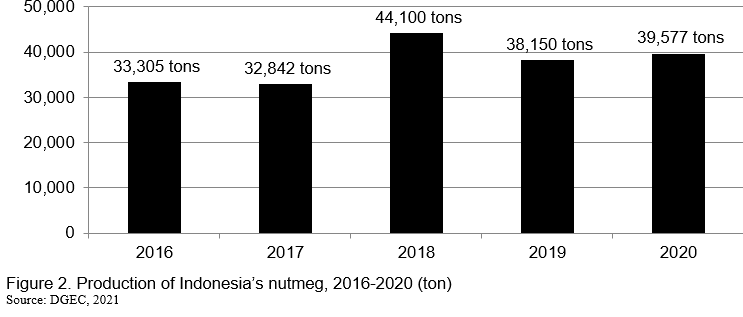
The average production of smallholder farms (38,970 tons) was much higher as compared to the average production of state institution farms (47 tons) and private sector farms (1 ton). During the last five years (2016-2020), the production of smallholder farms slightly increased by about 223 tons (2.15%) per year. Conversely, the production of state institution farms was decreased by about 12 tons (12.27%). The productivion of private-sector farms was kept stable (Table 2).

Productivity
The average productivity of Indonesia’s nutmeg was 479 kilograms per hectare (Figure 3). From 2016 to 2020, productivity slightly decreased by about four kg/ha (0.03%) per year. This productivity was higher than the global productivity, namely 301 kilograms per hectare (ICADIS, 2020). But it was lower as compared to the productivity of Malaysia (2,989 kg/ha), Sri Lanka (1,475 kg/ha), Dominica (1,224 kg/ha), Madagascar (1,035 kg/ha), and Togo (954 kg/ha).

As shown in Table 3, the average productivity of smallholder farms (493 kg/ha) was higher than those of private sector farms (250 kg/ha) and state institution farms (100 kg/ha). State institution and private sector farms are in the early stage of development, so that the productivity is still low, whereas small holder farms has been more stabilize. Overall, these productivities were low due to some reasons such as land climate suitability, plant materials used (limited superior variety), cultivation technology applied, and the presence of pests and diseases. The productivity of several varieties that have been released by the Ministry of Agriculture can potentially achieve about 3,700 kilograms per hectare (Suryadi, 2017 and Swadaya.com, 2021).

Consumption
Unfortunately, the data on nutmeg consumption were only available up to 2014. These data were derived from the National Socioeconomic Survey (Susenas) of the Indonesian Central Bureau of Statistics and calculated by ICADIS. Subsequently, nutmeg consumption data were included in other species groups i.e., nutmeg, ginger, turmeric, etc. From 2010 to 2014, the consumption of nutmeg tends to fluctuate, with a significant increase in 2013 (Figure 4).

Human resources
The human resource in Indonesia’s nutmeg farm comprises farmers and workers. Many human resources are farmers (99.89%), particularly smallholders. The rest are workers who work in nutmeg company belong to private sector. In 2020, the number of farmers was 268,569 households, while the number of workers was quite minor i.e., 292 people. The highest number was in eastern Indonesia, namely almost 60% of total number of nutmeg farmers in Indonesia. Detail number of Indonesia’s nutmeg farmers is presented in Figure 5.
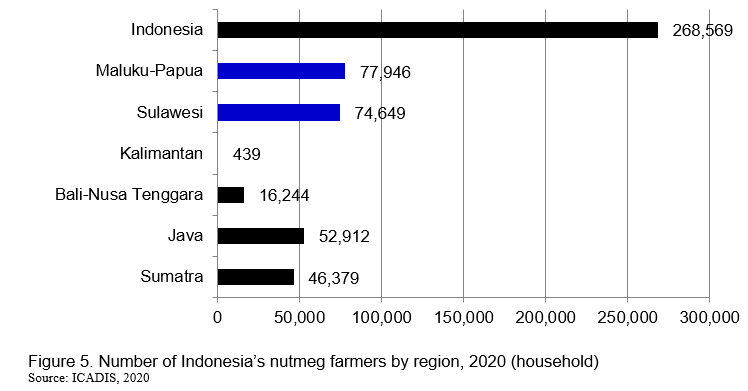
Marketing
In 2020, the average domestic price of nutmeg at the producer level was Rp46,620 (US$3.20) per kilogram (Figure 6). During this period, the price of nutmeg was relatively stable with an average change of about Rp731.21 (US$0.50) ((1.51%) per kilogram per month.
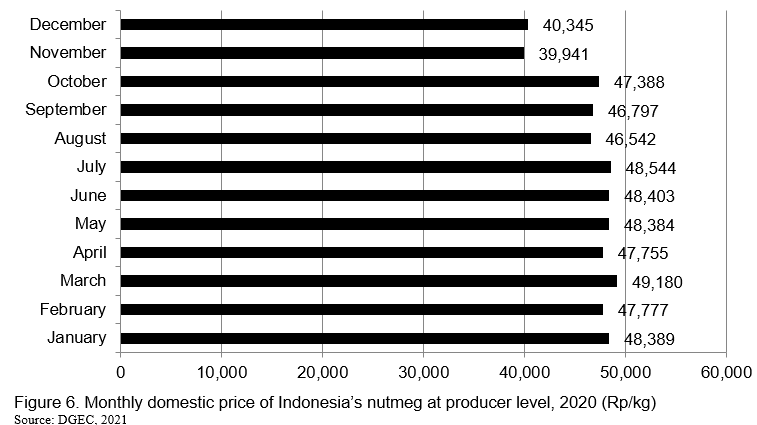
Over the last five years (2015-2019), the average domestic price of nutmeg at the producer level was Rp46,452 (US$3.19) per kilogram (Figure 7). The price tends to decrease by about Rp2,562 (US$0.18) per kilogram (5.39%) annually. Globally, the price of Indonesia’s nutmeg was US$3,811 per ton (ICADIS, 2020), lower than nutmeg prices of Bhutan (US$14,434/ton), Sri Lanka (US$11,969/ton), Nepal (US$6,065/ton) but higher than those of Canada (US$3,100/ton) and Ethiopia (US$ 607/ton). Lower price of Indonesia’s nutmeg compared to those of Bhutan, Sri Lanka, and Nepal is due to lower quality.

In the global market, Indonesia’s nutmeg can be classified as four Harmonized Commodity Description and Coding System (HS code), namely, (1) HS 0908110000 (uncrushed or unground); (2) HS 0908120000 (crushed or powdered); (3) HS 0908210000 (mace, neither crushed nor ground); and (4) HS 0908220000 (mace, crushed or ground).
From 2016 to 2020, the average export volume of Indonesia’s nutmeg was 19,754 tons with a value of US$121,562,000. Indonesia was ranked third as an exporter country of nutmeg in the world with a share of about 16.87%. Guatemala and India were ranked first and second with a share of 37.72% and 17.04%, respectively. The ranked fourth up to sixth were Nepal (5.78%), the Netherlands (3.94%), and the United Arab Emirates (2.91%). The share of other countries was about 15.74% (ICADIS, 2020). Meanwhile, the Indonesia’s average import volume of nutmeg was 318 tons with a value of US$1,540,000 (Table 4). As a result, Indonesia had a surplus in the global nutmeg market with a balance of trade of about US$117,023,200 per year.
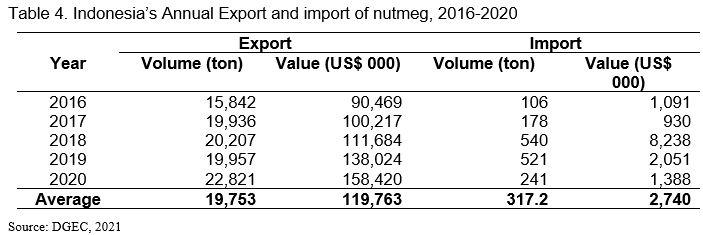
There were eight primary destination countries for Indonesia’s nutmeg exports. Almost half (50%) of nutmeg exports from Indonesia were to China, Vietnam, and India (Figure 8). It was noted that in 2019, Indonesia was the largest origin country of nutmeg because this commodity was re-exported or rejected by destination countries due to the presence of aflatoxins and mycotoxins. On the other hand, Indonesia also imported nutmeg, mainly from Vietnam, USA, Germany, Poland, and Colombia.
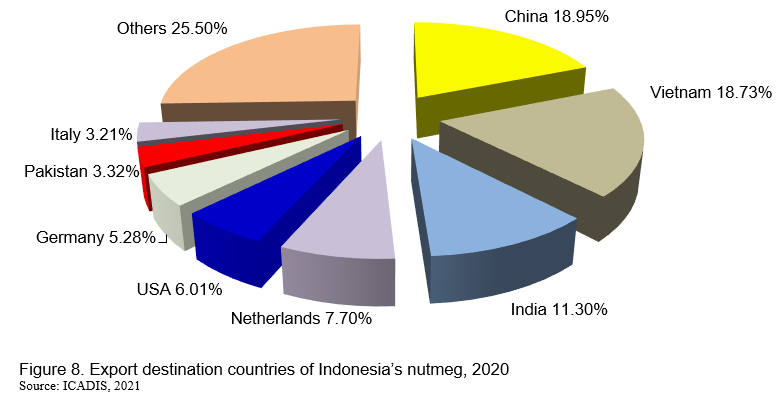
POLICY DEVELOPMENT
The government of Indonesia has some policies to increase the national productivity of nutmeg (MoA, 2012; MoA, 2018; MoA, 2020; and Hafif, 2021). The summary of essential policies is as follows:
- Regulation of Agricultural Ministry Number 53/2012 on Postharvest Handling of Nutmeg:
- It provides guidelines for farmers or farmer’s groups, field officers, and business actors in cultivating and post-harvest handling based on principles of Good Agricultural Practices (GAPs) and Good Handling Practices (GHPs).
- At the same time, it was also to respond the selling price of Indonesia’s nutmeg was only half that of Grenada’s nutmeg and lower than that of India’s nutmeg.
- Based on the considerations that nutmeg is a high-value, multi-purpose commodity, an export commodity, plays an important role in the national economy, and there is competition for the sale of nutmeg products on the world market, it requires the technological support and facilities for post-harvest nutmeg at farmers
- Decree of Ministry of Agriculture Decree Number 472/2018 on the Location of National Agricultural Areas:
- It regulates the priority commodity and area developments. The decision of this regulation was translated into a map of the commodity development plan area (InaAgrimap), including for the nutmeg commodity[1]
- In addition to providing information on zoning maps for nutmeg commodities, this website also provides information on superior varieties, cultivation techniques, and postharvest handling of nutmeg.
- This map is expected to assist the development of nutmeg based on land suitability and status.
- Regulation of Agricultural Ministry Number 7/2020 on General Guidelines for Supervision and Assistance in the Implementation of Main Programs and Activities of the Ministry of Agriculture:
- One of the assistance targets is to increase nutmeg production by 7% per year, increasing exports and product-added value. Mentoring activities involve all officials and technical officers at the central level down to the sub-district level.
- In 2021, this regulation was accelerated to support the Gratiek policy (Triple Export Movement) of the Ministry of Agriculture. Policies to improve postharvest handling and increase nutmeg production are starting to show results by increasing production, despite the price of nutmeg Indonesia’s price is still lower than the price of Grenada and India's nutmeg.
- The policy improvement strategy development of nutmeg in Indonesia is to increase the intensity of assistance, particularly in product quality improvement.
The government of Indonesia has also provided policy intervention about seed development. This is essential to see seed as a plant material and carrier of genetic potential as one of the factors that determine the success of plant cultivation and its role cannot be replaced by other factors, especially for superior variety. The superior varieties of nutmeg that have been released by the Indonesian Ministry of Agriculture are as follows (DGEC, 2022):
- Banda:
- Released: 28 December 2009 based on the Decree of Minister of Agriculture Number 4059/2009 – belongs to the government of Maluku province.
- Origin: Banda Islands (Central Maluku regency, Maluku province).
- Characteristics: (1) Dark green obovate leaf shapes; (2) The color of the fruit skin is brownish with a round slightly oval fruit shape; (3) The flesh is milky white; (4) The color of the shell is brownish black and the color of the mace is blood red; and (5) The aroma of the fruit and mace is sharp.
- Potential productivity: 167-5,120 nuts per tree per year with a fresh fruit weight of 9.83-59.50 grams and a flesh thickness of 0.18-1.00 centimeters.
- The essential oil content reaches 21.71%.
- Ternate 1:
- Released: 28 December 2009 based on the Decree of Minister of Agriculture Number 4061/2009 – belongs to government of North Maluku province and the Indonesian Industrial and Beverage Crops Research Institute (Sukabumi).
- Origin: Marikrubu, Ternate.
- Characteristics: (1) Dark green obovate leaf shape; (2) The color of skin is brownish with a round fruit shape; (3) The flesh is milky white; (4) The color of the shell is shiny brownish black; (5) The color of the mace is shiny blood red; and (6) The aroma of fruit and nutmeg mace is sharp, typical of nutmeg.
- Potential productivity: up to 7,595 seeds per tree per year with a fresh weight of fruit per grain of 0.52-87.00 grams and a flesh thickness of 1.12 centimeters.
- Essential oil content: 6.84-7.92%.
- Tidore 1:
- Released: 28 December 2009 based on the Decree of Minister of Agriculture Number 4062/2009 – belongs to the government of North Maluku province and the Indonesian Industrial and Beverage Crops Research Institute (Sukabumi).
- Origin: Jaya Tidore.
- Characteristics: (1) Has obovate leaves that are dark green to purplish brown; (2) The color of the skin is brownish red with a round fruit shape; (3) The flesh is light yellow; (4) The color of the shell is shiny brownish black; (5) The color of the mace is blood red; and (6) The aroma of fruit and nutmeg mace is sharp, typical of nutmeg.
- Potential productivity: up to 7,652 seeds per tree per year with a fresh weight of fruit per grain of 1.06-75.20 grams and a flesh thickness of 1.56 cm.
- Essential oil content: 12.35%.
- Tobelo 1:
- Released: 28 December 2009 based on the Decree of Minister of Agriculture Number 4063/2009 – belongs to the government of North Maluku province and the Indonesian Industrial and Beverage Crops Research Institute (Sukabumi).
- Origin: Wari Tobelo, North Halmahera Regency.
- Characteristics: (1) The skin is brownish red with a slightly oval shape, and the flesh is milky white; (2) The color of the shell is shiny brownish black; (3) The color of the mace is blood red; and (4) The aroma of fruit and nutmeg mace is sharp.
- Potential productivity: up to 7,650 seeds per tree per year with a fresh weight of fruit per grain of 1.23-79.62 grams and a flesh thickness of 0.17-1.37 centimeters.
- Essential oil content: 12.70%.
- Makian:
- Released: 26 January 2016 Decree of the Minister of Agriculture of the Republic of Indonesia. Number 72/2016 belongs to the government of North Maluku province.
- Origin: Makian (South Halmahera regency, North Maluku province.
- Characteristics: (1) Has a dark green canoe leaf shape; (2) Ivory yellow fruit skin color with round fruit shape; and (3) Shiny brownish black seed shell color and blood red mace color.
- Potential productivity: 2,500 nuts per tree, a potential production of 25 kilograms per tree of wet seeds with a fruit weight of 60.00-98.00 grams per grain and a flesh thickness of 1.00-1.80 cm.
- Essential oil content: 12.60%.
- Fakfak:
- Release: 14 February 2017 based on the Decree of the Minister of Agriculture of the Republic of Indonesia Number 95/2017 – belongs to the government of Fakfak regency (West Papua province).
- Origin: Fakfak regency (West Papua province).
- Characteristics: (1) Has obovate-lanceolate leaf shapes with a green upper leaf surface color and a whitish green lower leaf surface color; (2) The color of the fruit skin is brownish yellow with brown spots with an oval fruit shape; (3) The color of the shiny brownish black seed shell and the color of red mace; and (4) The aroma of mace is less sharp mace aroma.
- Potential productivity: 340-2,275 nuts per tree per year with a fruit weight of 105.60 grams per grain and a flesh thickness of approximately 1.55 cm.
- Essential oil content: 3.27%.
- Nurpakuan Agribun:
- Released: 1 February 2019 based on the Decree of the Minister of Agriculture of the Republic of Indonesia Number 22/2019 – belongs to the government of Bogor regency (West Java province).
- Origin: Bogor, West Java.
- Characteristics: (1) Has an obovate-lanceolate leaf shape; (2) The color of the upper surface of the leaf is green and the color of the lower surface is light green; (3) The color of the fruit skin is yellowish green with a round and round-oval fruit shape; (4) The color of the old seed shell is shiny brownish black and the fresh mace is red; and (5) The aroma of mace is sharp.
- Potential productivity: up to 8,730 seeds per tree in a year with fruit weights per grain ranging from 51.42 grams to 63.89 grams and flesh thickness of 1.05-2.30 cm.
- Essential oil content: 12.18%.
- Patani:
- Released: 31 March 2020 based on the Decree of the Minister of Agriculture of the Republic of Indonesia Number 47/2020 – belongs to the government of Central Halmahera regency.
- Origin: Central Halmahera regency, North Maluku province.
- Characteristics: (1) Type of composite variety resulting from natural cross-pollination in a population of Myristica succadanea; (2) Has a slightly elongated Kano leaf shape with a pointed tip; (3) Dark green leaf color with a rather smooth leaf surface; (4) The color of the ripe fruit is ivory yellow with a slightly oval fruit shape; and (5) The color of the shiny brownish black seed shell and the fresh mace is blood red.
- Potential productivity: 3,000-5,000 seeds per tree per harvest with an average fruit weight of 7.30 grams per grain, a flesh thickness of 1.00-1.70 cm, and a dry mace of 3.6 kilograms per tree
- Essential oil content: 8.50%.
- Tiangau Agribun:
- Released: 31 March 2020 based on the Decree of the Minister of Agriculture of the Republic of Indonesia Number 48/2020 – belongs to the government of Anambas Islands regency (Riau Islands province)
- Origin: the result of individual selection from the Anambas local nutmeg population
- Characteristics: (1) Has a lanceolate leaf shape-obovate, the upper surface of the leaf is green while the lower surface is grayish green; (2) The color of the ripe fruit is golden yellow with the shape of the fruit is round inverted (obovate); (3) The color of the dark seed shell is shiny blackish brown and the fresh mace is bright red; and (4) The aroma of mace is strong.
- Potential productivity: 3,138-11,064 nuts per tree per year with a fruit weight of 8.70-64.32 grams per grain and a flesh thickness of 0.93-1.24 cm.
- Essential oil content: 3.10-13.12%.
To improve the quality of nutmeg products, Indonesia has provided guidelines summarized in the Indonesian National Standard (SNI) Number 06-2388 of 2006 (National Standardization Agency, 2006) and ISO (International Standard Oil of Nutmeg) Number 3215 for the content of chemical compounds.
CONCLUSION AND RECOMMENDATIONS
Even though Indonesia is the largest nutmeg producer in the world, the productivity and export value of this commodity were still lower than those of other producing countries. Most nutmeg farms belong to smallholders, while the role of the private sector was quite minor. Hence, policy recommendations for nutmeg farms in Indonesia should focus on addressing the challenges faced by the industry and promoting sustainable practices including the following substances:
- Conducting training programs on good agricultural practices training program to enhance the skills of farmers in cultivating, harvesting, and postharvest processing of nutmegs;
- Establishing financial assistance programs, such as low-interest loans or grants, to help nutmeg farmers invest in modern farming equipment, infrastructure, and technology;
- Enforcing quality standards for nutmeg products to ensure compliance with international requirements through certification processes that enable nutmeg farmers to label their products as meeting specific quality and sustainability criteria, and enhancing market access; and
- Facilitating market linkages and partnerships between nutmeg farmers and buyers, both domestically and internationally toward reducing barriers and tariffs for nutmeg trades.
These policy recommendations are intended to create an enabling environment for nutmeg farmers, fostering a sustainable and resilient nutmeg industry in Indonesia. Implementation will require collaboration among government agencies, research institutions, non-governmental organizations, and the private sector.
REFERENCES
Bergman, S. 2022. Nutmeg: Health Benefits, Nutrition, and Uses. Retrieved from: https://www.webmd.com/ diet/nutmeg-health-benefits-nutrition-uses (10 December 2023)
DGEC. 2021. Statistik Perkebunan Unggulan Nasional 2020-2022 (Statistics of National Leading Estate Crops Commodity 2020-2022). Directorate General of Estate Crops. Indonesian Ministry of Agriculture. Jakarta.
DGEC. 2022. Mengenal Pala Varietas Unggul Nasional (Recognizing the National Superior Variety of Nutmeg). Directorate General of Estate Crops. Indonesian Ministry of Agriculture. Jakarta.
Hafif, B. 2021. Strategi Mempertahankan Indonesia sebagai Produsen Utama Pala Dunia (The Strategy to Maintain Indonesia as a Main Nutmeg Producer in the World). Jurnal Penelitian dan Pengembangan Pertanian (Journal of Agricultural Research and Development), Vol. 40 No. 1 June 2021: 58-70. Indonesia Agency for Agricultural Research and Development. Bogor.
ICADIS. 2020. Buku Outlook Komoditas Pekerbuan: Pala (Agricultural Commodity Outlook: Nutmeg Indonesian Center for Agricultural Data and Information System. Ministry of Agriculture. Jakarta.
MoA. 2012. Peraturan Menteri Pertanian Republik Indonesia Nomor 53 Tahun 2012 tentang Pedoman Penanganan Pascapanen Pala (Regulation of Agricultural Ministry Number 53/2012 on Postharvest Handling of Nutmeg). Indonesian Ministry of Agriculture. Jakarta.
MoA. 2018. Keputusan Menteri Pertanian Republik Indonesia Nomor 472 Tahun 2018 tentang Lokasi Kawasan Pertanian Nasional (Decree of Ministry of Agriculture Number 472/2018 on the Location of National Agricultural Areas). Indonesian Ministry of Agriculture. Jakarta.
MoA. 2020. Peraturan Menteri Pertanian Republik Indonesia Nomor 7 Tahun 2020 tentang Pedoman Umum Supervisi dan Pendampingan Pelaksanaan Program dan Kegiatan Utama Kementerian Pertanian Tahun Anggaran 2020 (Regulation of Agricultural Ministry Number 7/2020 on General Guidelines for Supervision and Assistance in the Implementation of Main Programs and Activities of the Ministry of Agriculture for Fiscal Year 2020). Indonesian Ministry of Agriculture. Jakarta.
Suryadi, R. 2017. Strategi Penelitian Budidaya untuk Meningkatkan Produktivitas dan Daya Saing Pala (Research Strategy of Cultivation to Improve Productivity and Competitiveness of Nutmeg). Perspektif, Vol. 16, No. 1, June 2017: 1-3. Retrieved from: http://dx.doi.org/10.21082/psp.v16n1.2016.01-13 (20 January 2023)
Swadaya.com. 2021. Teknologi Sambung Pucuk Tingkatkan Produktivitas Tanaman Pala (Shoot grafting technology increases the productivity of nutmeg plants). Retrieved from: https://www.swadayaonline.com/artikel/9122/Teknologi-Sambung-Pucuk-Tingkatkan-Produktivitas-Tanaman-Pala/ (20 January 2023).
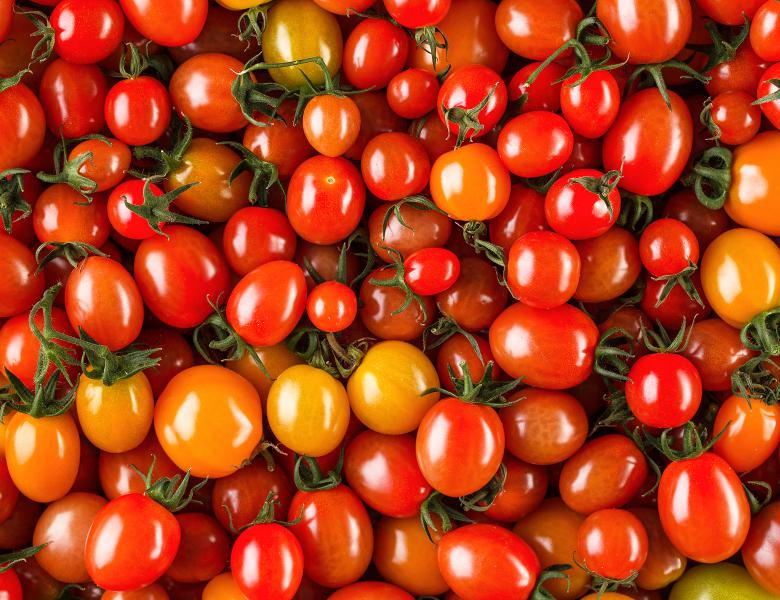


Policy Development of Indonesia’s Nutmeg
ABSTRACT
Indonesia is the largest nutmeg producer in the world sharing about 46.52% of the global harvested areas. Almost 60% of nutmeg planting areas are in eastern Indonesia, particularly in the Maluku and Papua regions. Most nutmeg farms belong to smallholders (99.81%). The productivity of Indonesia’s nutmeg was lower as compared to the productivity of other producing countries such as Malaysia, Sri Lanka, Dominica, Madagascar, and Togo. Indonesia was ranked third as an exporter country of nutmeg in the world with a share of about 16.87%. The government of Indonesia has some policies to increase the national productivity of nutmeg including seed development provision, especially for superior variety with high potential productivity. There is a need for policy recommendations to develop Indonesia’s nutmeg including training programs, financial assistance, quality standards, market linkages, and partnerships among government agencies, research institutions, non-governmental organizations, and the private sector.
Keywords: nutmeg, performance, development, policy, Indonesia
INTRODUCTION
Nutmeg (Myristica fragrans) is one of the most well-known spice commodities as categorized as a native commodity of Indonesia. This crop can grow all over areas of Indonesia, depending on land suitability, environmental circumstances, and cultivation practices. This commodity is a rich source of antioxidants, which help protect against the signs of aging and serious conditions such as cancer, heart, and liver diseases. Nutmeg may also provide other health benefits such as: (1) Relieving colds, indigestion, diarrhea, and stomach pain; (2) Improving memory and concentration abilities by stimulating the nerves in the brain; and (3) Preventing tooth decay and treating bad breath (Bergman, 2022).
The future perspective of this commodity is in line with the existing country’s economic growth, particularly in the Asian region. Thus, anchored in its historical value and contemporary needs, the development of Indonesia’s nutmeg is imperious. Re-establishing the past glory of this commodity will depend upon the ability and readiness of the country as well as an opportunity for foreign investments (Rafani, et.al, 2021). The central producing areas of nutmeg are in ten provinces of Indonesia. Almost 60% of nutmeg planting areas were in eastern Indonesia, particularly in the Maluku and Papua regions. The largest planting area was in the provinces of North Maluku, West Papua, and North Sulawesi (DGEC, 2021).
Indonesia was the largest nutmeg producer in the world sharing about 46.52% of the global harvested areas (ICADIS, 2020). It was followed by India (25.49%), Guatemala (19.40%), and other countries (8.60%). Nevertheless, Indonesia’s nutmeg farms have a problem since they are generally managed traditionally, both from cultivation up to post-harvest practices. Hence, it is necessary to develop the sustainability of nutmeg through policy intervention in the country.
PERFORMANCE
Nutmeg farms in Indonesia are classified into three cultivation managements’ smallholders, state institutions, and private sectors. Recently, most nutmeg farms belong to smallholders (99.81%) followed by state institutions (0.18%) and private sectors (0.01%). About 33.82% of nutmeg crops are under mature conditions, while 59.89% are immature and 6.29% are damaged (DGEC, 2021).
Planting area
In the last five years (2016-2020), the average planting area of nutmeg in Indonesia was about 220,032 hectares. During these periods, the planting areas increased by about 19,092 hectares (9.41%) per year i.e., from 178,333 hectares in 2016 to 254,699 hectares in 2020 (Figure 1).
Over the last five years (2016-2020), the planting area of smallholders and private sectors respectively increased by about 9.16% and 1.79% annually. Conversely, the farm of state institutions was decreased by about 0.82% per year (Table 1).
Production
The average production of Indonesia’s nutmeg was 37,595 tons (Figure 2). The production slightly increased by 211 tons (2.11%) per year from 2016 to 2020. The production of smallholder farms increased by 1,568 tons (5.78%) per year, namely from 33,305 tons in 2016 to 39,577 tons in 2020.
The average production of smallholder farms (38,970 tons) was much higher as compared to the average production of state institution farms (47 tons) and private sector farms (1 ton). During the last five years (2016-2020), the production of smallholder farms slightly increased by about 223 tons (2.15%) per year. Conversely, the production of state institution farms was decreased by about 12 tons (12.27%). The productivion of private-sector farms was kept stable (Table 2).
Productivity
The average productivity of Indonesia’s nutmeg was 479 kilograms per hectare (Figure 3). From 2016 to 2020, productivity slightly decreased by about four kg/ha (0.03%) per year. This productivity was higher than the global productivity, namely 301 kilograms per hectare (ICADIS, 2020). But it was lower as compared to the productivity of Malaysia (2,989 kg/ha), Sri Lanka (1,475 kg/ha), Dominica (1,224 kg/ha), Madagascar (1,035 kg/ha), and Togo (954 kg/ha).
As shown in Table 3, the average productivity of smallholder farms (493 kg/ha) was higher than those of private sector farms (250 kg/ha) and state institution farms (100 kg/ha). State institution and private sector farms are in the early stage of development, so that the productivity is still low, whereas small holder farms has been more stabilize. Overall, these productivities were low due to some reasons such as land climate suitability, plant materials used (limited superior variety), cultivation technology applied, and the presence of pests and diseases. The productivity of several varieties that have been released by the Ministry of Agriculture can potentially achieve about 3,700 kilograms per hectare (Suryadi, 2017 and Swadaya.com, 2021).
Consumption
Unfortunately, the data on nutmeg consumption were only available up to 2014. These data were derived from the National Socioeconomic Survey (Susenas) of the Indonesian Central Bureau of Statistics and calculated by ICADIS. Subsequently, nutmeg consumption data were included in other species groups i.e., nutmeg, ginger, turmeric, etc. From 2010 to 2014, the consumption of nutmeg tends to fluctuate, with a significant increase in 2013 (Figure 4).
Human resources
The human resource in Indonesia’s nutmeg farm comprises farmers and workers. Many human resources are farmers (99.89%), particularly smallholders. The rest are workers who work in nutmeg company belong to private sector. In 2020, the number of farmers was 268,569 households, while the number of workers was quite minor i.e., 292 people. The highest number was in eastern Indonesia, namely almost 60% of total number of nutmeg farmers in Indonesia. Detail number of Indonesia’s nutmeg farmers is presented in Figure 5.
Marketing
In 2020, the average domestic price of nutmeg at the producer level was Rp46,620 (US$3.20) per kilogram (Figure 6). During this period, the price of nutmeg was relatively stable with an average change of about Rp731.21 (US$0.50) ((1.51%) per kilogram per month.
Over the last five years (2015-2019), the average domestic price of nutmeg at the producer level was Rp46,452 (US$3.19) per kilogram (Figure 7). The price tends to decrease by about Rp2,562 (US$0.18) per kilogram (5.39%) annually. Globally, the price of Indonesia’s nutmeg was US$3,811 per ton (ICADIS, 2020), lower than nutmeg prices of Bhutan (US$14,434/ton), Sri Lanka (US$11,969/ton), Nepal (US$6,065/ton) but higher than those of Canada (US$3,100/ton) and Ethiopia (US$ 607/ton). Lower price of Indonesia’s nutmeg compared to those of Bhutan, Sri Lanka, and Nepal is due to lower quality.
In the global market, Indonesia’s nutmeg can be classified as four Harmonized Commodity Description and Coding System (HS code), namely, (1) HS 0908110000 (uncrushed or unground); (2) HS 0908120000 (crushed or powdered); (3) HS 0908210000 (mace, neither crushed nor ground); and (4) HS 0908220000 (mace, crushed or ground).
From 2016 to 2020, the average export volume of Indonesia’s nutmeg was 19,754 tons with a value of US$121,562,000. Indonesia was ranked third as an exporter country of nutmeg in the world with a share of about 16.87%. Guatemala and India were ranked first and second with a share of 37.72% and 17.04%, respectively. The ranked fourth up to sixth were Nepal (5.78%), the Netherlands (3.94%), and the United Arab Emirates (2.91%). The share of other countries was about 15.74% (ICADIS, 2020). Meanwhile, the Indonesia’s average import volume of nutmeg was 318 tons with a value of US$1,540,000 (Table 4). As a result, Indonesia had a surplus in the global nutmeg market with a balance of trade of about US$117,023,200 per year.
There were eight primary destination countries for Indonesia’s nutmeg exports. Almost half (50%) of nutmeg exports from Indonesia were to China, Vietnam, and India (Figure 8). It was noted that in 2019, Indonesia was the largest origin country of nutmeg because this commodity was re-exported or rejected by destination countries due to the presence of aflatoxins and mycotoxins. On the other hand, Indonesia also imported nutmeg, mainly from Vietnam, USA, Germany, Poland, and Colombia.
POLICY DEVELOPMENT
The government of Indonesia has some policies to increase the national productivity of nutmeg (MoA, 2012; MoA, 2018; MoA, 2020; and Hafif, 2021). The summary of essential policies is as follows:
The government of Indonesia has also provided policy intervention about seed development. This is essential to see seed as a plant material and carrier of genetic potential as one of the factors that determine the success of plant cultivation and its role cannot be replaced by other factors, especially for superior variety. The superior varieties of nutmeg that have been released by the Indonesian Ministry of Agriculture are as follows (DGEC, 2022):
To improve the quality of nutmeg products, Indonesia has provided guidelines summarized in the Indonesian National Standard (SNI) Number 06-2388 of 2006 (National Standardization Agency, 2006) and ISO (International Standard Oil of Nutmeg) Number 3215 for the content of chemical compounds.
CONCLUSION AND RECOMMENDATIONS
Even though Indonesia is the largest nutmeg producer in the world, the productivity and export value of this commodity were still lower than those of other producing countries. Most nutmeg farms belong to smallholders, while the role of the private sector was quite minor. Hence, policy recommendations for nutmeg farms in Indonesia should focus on addressing the challenges faced by the industry and promoting sustainable practices including the following substances:
These policy recommendations are intended to create an enabling environment for nutmeg farmers, fostering a sustainable and resilient nutmeg industry in Indonesia. Implementation will require collaboration among government agencies, research institutions, non-governmental organizations, and the private sector.
REFERENCES
Bergman, S. 2022. Nutmeg: Health Benefits, Nutrition, and Uses. Retrieved from: https://www.webmd.com/ diet/nutmeg-health-benefits-nutrition-uses (10 December 2023)
DGEC. 2021. Statistik Perkebunan Unggulan Nasional 2020-2022 (Statistics of National Leading Estate Crops Commodity 2020-2022). Directorate General of Estate Crops. Indonesian Ministry of Agriculture. Jakarta.
DGEC. 2022. Mengenal Pala Varietas Unggul Nasional (Recognizing the National Superior Variety of Nutmeg). Directorate General of Estate Crops. Indonesian Ministry of Agriculture. Jakarta.
Hafif, B. 2021. Strategi Mempertahankan Indonesia sebagai Produsen Utama Pala Dunia (The Strategy to Maintain Indonesia as a Main Nutmeg Producer in the World). Jurnal Penelitian dan Pengembangan Pertanian (Journal of Agricultural Research and Development), Vol. 40 No. 1 June 2021: 58-70. Indonesia Agency for Agricultural Research and Development. Bogor.
ICADIS. 2020. Buku Outlook Komoditas Pekerbuan: Pala (Agricultural Commodity Outlook: Nutmeg Indonesian Center for Agricultural Data and Information System. Ministry of Agriculture. Jakarta.
MoA. 2012. Peraturan Menteri Pertanian Republik Indonesia Nomor 53 Tahun 2012 tentang Pedoman Penanganan Pascapanen Pala (Regulation of Agricultural Ministry Number 53/2012 on Postharvest Handling of Nutmeg). Indonesian Ministry of Agriculture. Jakarta.
MoA. 2018. Keputusan Menteri Pertanian Republik Indonesia Nomor 472 Tahun 2018 tentang Lokasi Kawasan Pertanian Nasional (Decree of Ministry of Agriculture Number 472/2018 on the Location of National Agricultural Areas). Indonesian Ministry of Agriculture. Jakarta.
MoA. 2020. Peraturan Menteri Pertanian Republik Indonesia Nomor 7 Tahun 2020 tentang Pedoman Umum Supervisi dan Pendampingan Pelaksanaan Program dan Kegiatan Utama Kementerian Pertanian Tahun Anggaran 2020 (Regulation of Agricultural Ministry Number 7/2020 on General Guidelines for Supervision and Assistance in the Implementation of Main Programs and Activities of the Ministry of Agriculture for Fiscal Year 2020). Indonesian Ministry of Agriculture. Jakarta.
Suryadi, R. 2017. Strategi Penelitian Budidaya untuk Meningkatkan Produktivitas dan Daya Saing Pala (Research Strategy of Cultivation to Improve Productivity and Competitiveness of Nutmeg). Perspektif, Vol. 16, No. 1, June 2017: 1-3. Retrieved from: http://dx.doi.org/10.21082/psp.v16n1.2016.01-13 (20 January 2023)
Swadaya.com. 2021. Teknologi Sambung Pucuk Tingkatkan Produktivitas Tanaman Pala (Shoot grafting technology increases the productivity of nutmeg plants). Retrieved from: https://www.swadayaonline.com/artikel/9122/Teknologi-Sambung-Pucuk-Tingkatkan-Produktivitas-Tanaman-Pala/ (20 January 2023).
[1] It can be accessed via: http://inaagrimap.litbang. agriculture.go.id/index.php/sentra-production/tanaman-perkebunan/nutmeg